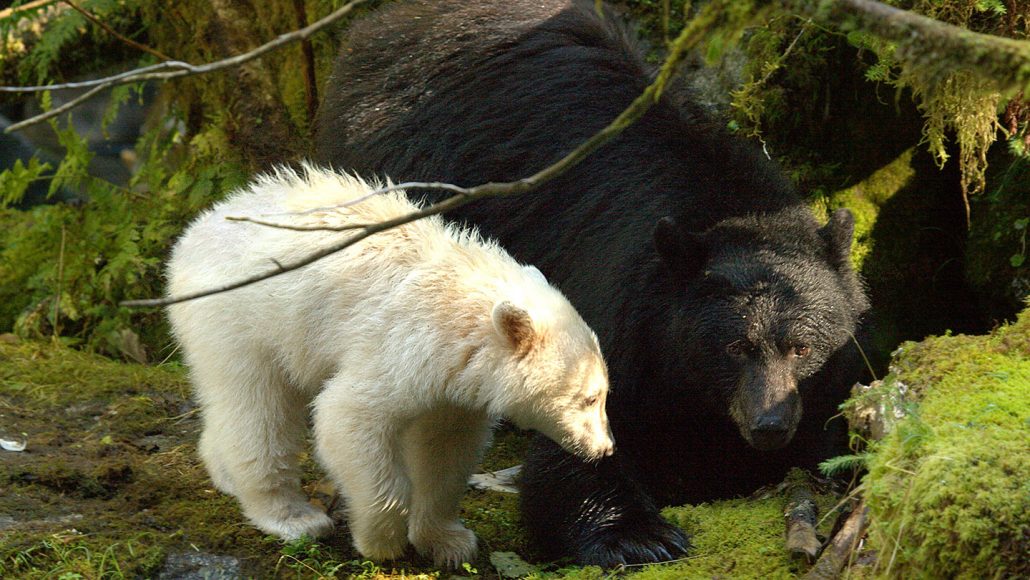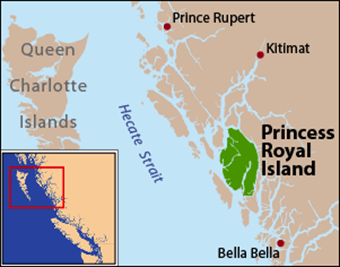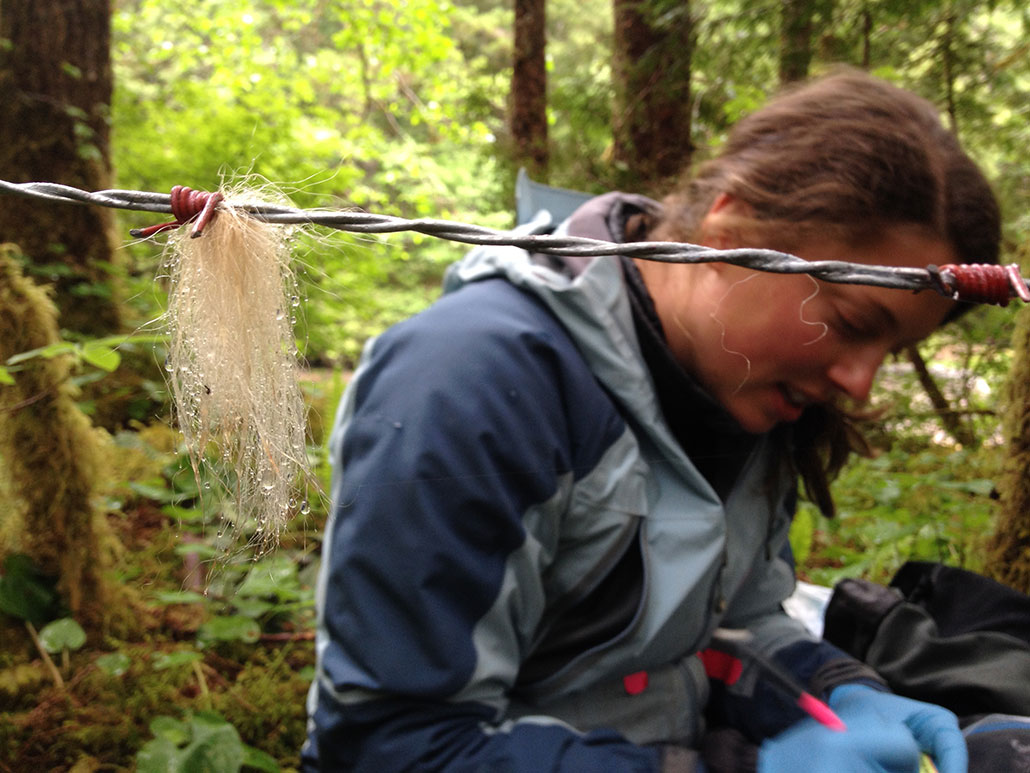Science and Indigenous history team up to help spirit bears
Researchers find truth in a tale of mythical white bears

A baby spirit bear (left) with its mother. Spirit bears are a type of black bear with snow-white fur.
D. Neasloss
Indigenous people in what is now the Great Bear Rainforest of western Canada tell a story about the bears there. When the Raven — or Wee’get — created the world, he also created the Ice Age. When the ice finally began to melt, Raven wanted to do something to remind himself of that time. As he flew over an island near the Great Bear Rainforest, Raven saw a black bear. He decided to turn every 10th black bear white. He set the white bears on what is now Princess Royal Island, where they would be protected, to remind Raven forever of when the world was cold.
The tale has basis in truth. White bears can be found on Princess Royal and other nearby islands. They are not polar bears (Ursus maritimus). Also called the Kermode bear, they are a subspecies of black bears that has white fur (Ursus americanus kermodei). The First Nations people of Canada call them spirit bears. Scientists are now working with Indigenous people living in the Great Bear Rainforest to better understand these special bears.

Douglass Neasloss first heard Raven story from someone in the Gitga’at First Nation in British Columbia, Canada. Neasloss is a member of the nearby Kitasoo/Xai’xais (“KIT-ah-soo/Shah-Shah”) First Nation, also in British Columbia. He began working as a Great Bear Rainforest tour guide back in 1999. He showed people plenty of black bears. All were black. He was skeptical about the tale that some were white. “I grew up in this community,” he recalls. “I thought there was no such thing.”
Then, a Japanese film crew hired him to find a spirit bear. “I thought [the director] was pulling my leg,” Neasloss says. “I went for a walk … and this spirit bear walks right in front of me…. He’s got a salmon in his mouth…. And the sun comes out, peeking through the trees, and lights up his face.”
Neasloss is now a stewardship director for the Kitasoo/Xai’xais First Nation. And his Kitasoo/Xai’xais name is now Nuq’vas glaw — white bear. His job is to help animals and people live together, especially people and bears. He also works with scientists studying spirit bears and salmon. “We have, you know, 10,000-plus years of living in this area,” he notes. “You’d think we know something about the wildlife, how to coexist with one another here.”
Spirit bear science
To help them better understand the bears and salmon in their community, the Kitasoo/Xai’ais hired Christina Service. She’s a wildlife biologist and the first scientist this First Nation had ever hired. Often, her research is inspired by stories the First Nations tell or knowledge they already have. That includes their knowledge of spirit bears.
Service and Neasloss wanted to figure out how many bears were white. Their color is due to a single gene — a chunk of DNA — with instructions for white fur. The gene is recessive. Bears inherit a gene for fur color from each of their parents. Both parents need to pass on a copy of the “white fur” gene for a cub to be white. If either parent passes along a gene for any other fur color, such as black or brown, the cub will be that color instead.
If genes for black and white fur are distributed evenly among the island’s bear population, about one in of every four should be white. But if 25 percent of the bears were white, the Kitasoo/Xai’xais couldn’t find them. And many tourists search for spirit bears in the Great Bear Rainforest. Knowing how rare the bears truly were could help guide how to protect them.
Getting a bear’s DNA is not easy. Some scientists visit them in dens to take samples. But bears are very important in Kitasoo/Xai’xais culture, and Service and Neasloss wanted to make sure that their research didn’t disturb the bears. So they constructed a hair trap with a strip of cloth soaked in fish guts, peanut butter and bacon. (Bears find those smells irresistible.) They placed the stinky cloth inside a ring of barbed wire. The wire doesn’t hurt the bears, but as they step over it, it snags a small clump of their fur — just enough to get a DNA sample.

By collecting hair from all over the islands where the bears lived, the traps showed that spirit bears were much rarer than scientists had assumed. In fact, on Princess Royal Island, only about one in every 10 is white. Those numbers match well with local knowledge. “We were able to look and compare to what the communities knew … based on oral history,” Service says.
The scientists also showed that only about half of the areas that were home to the most spirit bears were protected by the government. So to help preserve spirit bears, more land might have to be protected as well. Service, Neasloss and their colleagues published their analyses last December in Ecological Solutions and Evidence.
“I really love the research they do because it’s such a close collaboration with the First Nations,” says Natalie Ban. “I think the approach they take is admirable and should be an example for other ecologists and biologists to follow.” Ban is a conservation scientist at the University of Victoria in Canada. She was not involved in the research.
Ban says that while the numbers of spirit bears are interesting, it’s where they are that’s most important. Many spirit bears live in unprotected forest. “Those places are potentially subject to logging,” she notes, as well as other human activities that might harm the bears’ habitat.
But habitat protection is just a first step, she adds. Protecting these animals, she adds, “ought to involve rethinking how much we extract from the environment.”
And this could also help the main local industry: ecotourism — people coming to see the rainforest and its bears. Neasloss hopes that more science will help benefit all of the bears. “We have a lot of respect for these bears,” he says. “A long time ago people used to share the same rivers and estuaries with these bears, to share the forest.” That respect means learning about them and keeping them safe — for the bears and the people who want to see them. “The bears deserve to be here as much as the people do.”







